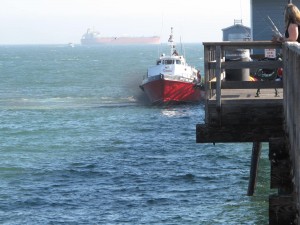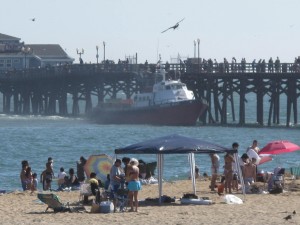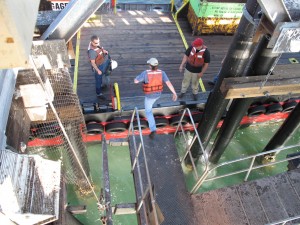What the oil boats cost Seal Beach visitors health ?
March 31, 2010 by Wilm
Filed under Green Issues, Local News
EPA’s Recent Assessment of Toxic Air Pollutants and their affect on you.
The EPA has released the latest version of a state-of-the-science tool that estimates health risks from breathing air toxics in the United States. The National Air Toxics Assessment (NATA), based on 2002 air emissions data, helps state, and local governments identify areas and specific pollutants to better understand risks they may pose.
Air toxics are of concern because they are known to, or are suspected of, causing cancer and other serious health problems, including birth defects. The report assessed 180 air toxics plus diesel particulate matter from stationary sources of all sizes and from mobile sources such as cars, trucks, buses and construction equipment.
The 2002 NATA estimates that most people in the United States have an average cancer risk of 36 in 1 million if exposed to 2002 emissions levels over the course of their lifetime. In addition, 2 million people—less than one percent of the total U.S. population—have an increased cancer risk of greater than 100 in 1 million.
HOW IT AFFECTS SEAL BEACH

One thing not included in the study is any harm caused by diesel pollutants that come from the “oil boats”, “Capt. T Li” and “Peter Mac”, that regularly pick up men and equipment from the Seal Beach Pier. Whats Up in Seal Beach estimates there are not less than 20 pick-ups and drop offs in each 24 hour period.
The boats pull up next to the pier and NEVER shut off their engines. We’re told that’s the city’s decision.Clouds of noxious fumes affect fisherman and people on the pier a few feet away. Also affected are surfers and boogie boarders nearby and, when the wind is offshore Ruby’s diner 100 feet away.
TODDLERS PLAYGROUND
Most important is the play area for our children. It is only a few hundred yards away and the prevailing winds suck the fumes directly in that direction. When you read EPA reports of toxic fumes you’ll notice there is always an emphasis on what the fumes do to small children and pregnant women.
Sometimes the boat is running (and spewing fumes) for considerable periods. The photos above were taken on July 4th and prevailing winds were strong enough that day that the fumes shown are pretty well dispersed and do not accurately show how concentrated they are most of the time. On Independence day the “Peter Mac” was at the pier for almost 45 minutes waiting for ONE person.
TRUCKS CONTROLLED, HARBOR BOATS ARE NOT?
California state law states that a diesel truck operating in the harbor can only idle for 5 minutes….after 5 minutes if it doesn’t shout down it is fined. The oil boats have diesel engines 10 times as big as a diesel truck yet they can run those engines next to an exposed group of holiday beachgoers for 45 minutes!
CHILDREN’S HEALTH STUDY
According to the Clean Air Task Force in diesel engine particulates carry a number of potent carcinogens. In children, particulate matter has also been associated with crib death. A 2004 study showed that particles and nitrogen dioxide have chronic adverse effects on lung development 10-18 year olds leading to deficits in lung function as the children reached adulthood. What’s more, diesel engines also release other gases such as carbon monoxide and nitrogen oxides that form ground level ozone. Results of the California Children’s Health Study suggest that ozone is associated with birth defects and new diagnoses of asthma.
PIER DAMAGE OVERESTIMATED?
Since the oil boats approach from the east side of the pier they are usually being pushed away by the prevailing winds, so the engine is always working hard to push the boat back to the dock. If the boats tied-up at the loading dock they could shut their engines or at least reduce them to “idle mode.”
NO TIE-UP MEANS WORKERS MUST JUMP ON BOARD
The city says that they do not want the ship to tie-up because if they did the operators might bang into the pier and do damage to the pier. (What does the city think happens to the pier when the boat is being constantly pushed away by wave action and has to keep pushing back?) The photo below shows a worker jumping on board.

Admittedly a small jump and not a big risk, however, when it is repeated 100 times in 24 hours, sometimes in dark and inclement weather; and often with an exhausted worker at the end of a long day…the risk to injury or death increases exponentially.
We’ve seen senior boat operators who could put a vessel a lot bigger than the oil boats next to a dock as gently as one would stroke a kitten. If the operators did that they could tie-up without any damage to the pier. As it is presently done the boat MUST bump the dock several times because it is constantly being pushed off by wave action and prevailing winds. Even if there was a chance of occasional harder pier bumps the boat operator could easily carry a bond that would cover any possible damage to the pier.
DO WE EVEN NEED THE OIL BOATS AT OUR PIER?
If we don’t allow the boats to use the pier there are lots of other options for them. Alamitos Bay has a usable pier which they use when they can’t come here. Perhap the Belmont Pier ? Huntington Beach has both a helicopter pad and a pier…but maybe Huntington is more conscious of their pier users and doesn’t want the oil boats there. Yes we’d lose some revenue but is the revenue generated enough to justify the risks to the health of our citizens and visitors. Might we be held mutually liable for health risks to nearby residents who are forced to breath substantially more of these carcinogens brought into the city by a contract between the city and boat operator?
NATA provides broad estimates of risk over geographic areas of the country and not definitive risks to specific individuals. The results are best used to prioritize pollutants and areas for further study, not as the sole basis for regulation or risk reduction activities.
Since the 1990 Clean Air Act Amendments, air toxic emissions have decreased by 40 percent from all sources. NATA can be used to help all levels of government target further reductions in air toxics emissions.
FOR MORE INFORMATION :
Diesel and Health in America: The Lingering Threat
http://www.catf.us/publications/view/83
www.epa.gov/oar/toxicair/newtoxics.html






thank you for writing this article. i have often wondered, what are these boats doing off the pier? They are an eyesore, noisy, obnoxious polluters. They never see, to shut the engines down. When i first noticed the guys working on them i thought they were from Mars. the workers hop on and hop off without as much as a Hello to anyone. Its is a very strange Vibe i recieve from them. After reading your article, now i understand why.
Great Article, thank you. I have to breathe these fumes day and night, especially at night with choking and coughing. They could easily change these engines over to Natural Gas like the City Fleet vehicles.
And why such a big boat to ferry just a few to and from the rig ?
This situation is a health hazzard to surfers and sunbathers alike and should be stopped.
What can we do to facilitate these changes ?